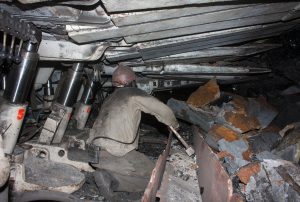Print a Sign-In Sheet | Spanish Version Coming Soon
What is a confined space?
A confined space is defined as a space large enough and configured that an employee can bodily enter and perform work, has limited or restricted means for entry and/or exit, and is not designed for continuous employee occupancy. A confined space must meet all 3 requirements.
What is a permit-required confined space?
A permit-required confined space contains or has:
- potential to contain a hazardous atmosphere (flammable gas, oxygen deficiency, combustible dust, etc.)
- a material that could engulf an entrant
- an internal configuration that could trap or harm the entrant with sloping floors or converging walls
- the possibility to contain any other serious safety or health hazard.
(Must have one of the characteristics to be a permit required confine space.)
What is a confined space in construction?
- A confined space in construction is defined as building a new structure or replacing/upgrading an old structure.
- Here are some possible confined spaces in construction:
- Pits
- Sewers
- Pipes or piping
- Grain bins
- Machinery large enough to enter
- Excavation (An excavation is still covered under 1926.650 Subpart P unless an employee must enter a confined space within an excavation such as a pipe.
The differences between the Confined Space General Industry Standard and the Construction Industry Standard (The construction standard is similar to the general industry standard with some additional requirements.):
- A competent person must conduct worksite evaluations. A competent person is defined as one who can identify existing and predictable hazards in the surroundings or working conditions which are unsanitary, hazardous, or dangerous to employees, and who has the authorization to take prompt corrective measures to eliminate them.
- Employers using “alternate procedures” for permit space entry must prevent physical hazard exposures through elimination or isolation through methods such as lock-out/tag-out.
- Permits can be suspended instead of canceled, provided space is returned to permit conditions prior to entry. Under the general industry standard, if a hazardous condition was to occur during the entry then the permit must be canceled.
- Under the construction standard, the permit can be canceled or suspended until the hazard is corrected and space is returned to the conditions prior to the original entry.
- Continuous monitoring of atmospheric and engulfment hazards.
- Employers relying on local emergency services for rescue must arrange for responders to notify in advance if responders are unavailable. The new construction standard states that rescue services must contact the employer if they are unavailable.
- Specific information exchange requirements for multi-employer worksites. The rule makes the controlling contractor, rather than the host employer, the primary point of contact for information about permit spaces at the worksite. The host employer must provide information it has about permit spaces at the worksite to the controlling contractor, who then passes it on to the employers whose employees will enter the spaces (entry employers). Likewise, entry employers must give the controlling contractor information about their entry program and hazards they encounter in the space, and the controlling contractor passes that information on to other entry employers and back to the host.
KEMI does not assume liability for the content of information contained herein. Safety and health remain your responsibility. This information is to be used for informational purposes only and not intended to be exhaustive or a substitute for proper training, supervision or manufacturers’ instructions/recommendations. KEMI, by publication of this information, does not assume liability for damage or injury arising from reliance upon it. Compliance with this information is not a guarantee or warranty that you will be in conformity with any laws or regulations nor does it ensure the absolute safety of any person, place or object, including, but not limited to, you, your occupation, employees, customers or place of business.

